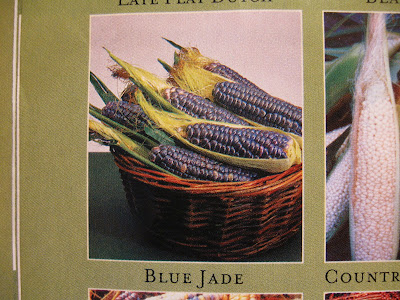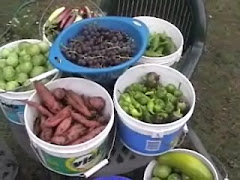I have listed a few more things that we will be attempting to grow this year and will be new additions to our garden.
From Baker Creek Heirloom Seeds:
Giant Cape Gooseberry (Physalis peruviana L) - The cape gooseberry is native to Brazil and was cultivated by early settlers at the Cape of Good Hope on the coast of South Africa. A perennial vining plant that can be anywhere from 2 to 6 ft. in height depending on growing conditions. Does well where tomatoes are grown and likes a sunny frost free environment. It should not be fertilized as it will easily put out an overabundance of vegetative growth at the expense of it's fruit development. The fruit grows in a paper husk and can be harvested after it turns yellow and falls to the ground. It has a similar sweet taste to it's smaller cousin the common ground cherry. In a side note, ground cherry's hold up fairly well in storage and even increase in flavor, we have had some last over 2 months at around 50°.

 http://creativecommons.org/licenses/by-sa/2.5/
http://creativecommons.org/licenses/by-sa/2.5/
Litchi Tomato aka Sticky Nightshade (S. sisymbriifolium) - A large plant that can grow around 5' tall and is covered in thorns. The prickly husk covered fruit is the size of a cherry tomato and supposedly tastes like a cross between a tomato, tart cherry, and watermelon. This "Wild Tomato" can be grown as you would any tomato but may not be a very prolific producer, nonetheless it certainly piqued my interest.

Black Seed Sesame (Sesamum indicum L) - An annual that grows 2-3' tall and germinates well in warm soils, seeds mature within 120 days. The seeds are highly nutritious, rich in manganese, copper, and a great source of calcium they also contain vitamin B1 and E. Black sesame may be eaten raw (dried) or toasted, and reportedly has a sweet nutty flavor and can be used to make a fine sesame oil. I am really looking forward growing this one for myself and the chickens.


Chichiquelite Huckleberry or Petty Morel (Solanum nigrum) - A member of the black nightshade family this plant produces fruit that is supposed to be much better tasting then it's counter parts the Garden huckleberry and Wonderberry. The flowers are small and white and are succeeded by small round polished appearing berries, green at first, but black when ripe. The green berries are possibly poisonous and care should be taken around small children. Can be grown as a tomato or ground cherry...may be better adapted to lower light conditions then the aforementioned. It is possible that this plant grows wild around my place and I have always considered it to be poisonous, it will be interesting to see if this is really it. Some say the leaves are even edible...not sure if I am that brave. Of course it was only a few 100 years ago that tomatoes (another nightshade) were considered poisonous also.
 Orange Fleshed Purple Smudge Tomato
Orange Fleshed Purple Smudge Tomato - An indeterminate heirloom producing 4-10 ounce fruits, 80 to 90 days after transplanting. Orange in color with true purple pigment mixed in. Light, cool weather, and soil conditions may increase the purple color. This tomato may have more going for it in color than in taste from what I've read, but I am game to give it a try. You know how good those purple pigments are supposed to be health wise.
From Seed Saver Exchange:
 Mongolian Giant Sunflower
Mongolian Giant Sunflower (H. Annuus) - Grows up to 14' tall, heads 16-19" across with 1 ½" long sunflower seeds - 90days...It's big.

Applegreen Eggplant - 5" mild flavored oval fruits are supposed to bear dependably in northern gardens due to early fruiting... 60-70 days. Plants are small and productive. I always have luck with eggplants but this one really sounds perfect for our north Idaho garden.
 Purple Pod Pole Bean
Purple Pod Pole Bean - Discovered in an Ozark garden in the 1930's, plants climb upwards of 6' and are very productive. Pods are stringless and 5-7" long, purple in color. 68 days to maturity.

Blacktail Mtn. Watermelon - From SSE catalogue - Developed by SSE member Glenn Drowns when he lived in northern Idaho, where summer nights average 43° F. Round 9" dark green fruits weigh 6-12 pounds. Sweet, juicy, crunchy, scarlet flesh. Does well in hot, humid climates too. Reliable crops. 70-75 days. Developed in north Idaho, what else could I ask for.
 Charentais/Charantais Melon or Cavaillon
Charentais/Charantais Melon or Cavaillon - Popular in seventeenth century France they are a true cantaloupe, globe shaped, around 3 1/2" - 6" in diameter and weighing 2 pounds each, creamy green to golden beige in color. It is a very aggressive grower, producing many long vines and needs a lot of room. Because Charentais is a sweet fruit, it often attracts ants and other insects that bore into the melon from the ground, so it is best grown off the ground on a strong trellis. This melon reaches maturity between 85-90 days after planting. They have a superior eating quality and heady, perfumed aroma. Their flesh is softer than that of a cantaloupe, and their flavor is deeper and sweeter. A good source of potassium and vitamin C.
From Fedco: Sea Kale
Sea Kale (Crambe maritima - Family Cruciferae [Brassicaceae] ) - A perennial member of the Cabbage family that grows wild along the coasts of Europe and Ireland, and was one of the traditional plants taken on voyages as a preventative against scurvy, possibly where it gets it's name. It has large blue green leaves and will eventually burst out in a profusion of white flowers. The plant is often grown for use as a blanched vegetable and is an excellent source of Vitamin C. Before winter the roots can be lifted for early forcing in a heated place, or left until spring and forced by covering with a large pot or other container that excludes all light.
Gigante Kohlrabi or Superschmeltz - High quality, open pollinated Czechoslovakian heirloom that often exceeds 10 pounds. The world record was 62 pounds. It has a mild sweet flavor and good texture..even in comparison to it's smaller counterparts. Like all Kohlrabi they do well in a heavy, slightly alkaline soil. They take 120-130 days to mature, but really, I think a 90 day 5 pounder would probably be OK also.
Paul Robeson Tomato - This indeterminate heirloom was renamed for the human rights activist, actor, opera singer and much more... Paul Robeson who was especially appreciated in Russia. This tomato, named in his honor, is a medium-sized black beefsteak with dark exterior flesh but a ruby red inside and is reportedly very flavourful. Developed in Russia, it should do well in northern gardens. There is a picture of this beauty at Daves Garden -
http://davesgarden.com/guides/pf/showimage/129410/ Spilanthes
Spilanthes - (
Acmella Oleracea) Spilanthes is also known as the toothache plant because when you chew on the salty flavored leaves or flowers it produces a numbing effect to the tongue and gums and can be used in this manner to help ease the pain of a toothache. Spilanthes is a native of South America and grows well in full sun to partial shade reaching a height of 12-15". It is easily grown from seed but can also be propagated by stem cuttings. Spilanthes does well in any medium moist soil and should not be planted out until after all danger of frost as it is not at all cold hardy. This strong anti-bacterial herb is currently being investigated for a wide variety of other therapeutic properties. It should be most interesting to say the least.
If anyone has tried these particular plants please let me know your thoughts regarding them.
 The grandson and I decided to hunt for buried treasure this afternoon, as he is currently in a pirate phase. We soon unearthed our booty in the form of sun roots... "Are those potatoes grandpa?" he asked somewhat disappointed. I spend a great deal of time teaching the boy about things, many things , and today was a lesson on sunroots, sunchokes, Jerusalem Artichokes, or any number of names. I like sunroots as that is supposed to be what the original (native) Americans called one of this country's few indigenous tubers.
The grandson and I decided to hunt for buried treasure this afternoon, as he is currently in a pirate phase. We soon unearthed our booty in the form of sun roots... "Are those potatoes grandpa?" he asked somewhat disappointed. I spend a great deal of time teaching the boy about things, many things , and today was a lesson on sunroots, sunchokes, Jerusalem Artichokes, or any number of names. I like sunroots as that is supposed to be what the original (native) Americans called one of this country's few indigenous tubers.







 Upon readiness they were added with onions to the cook pan for a good fry.
Upon readiness they were added with onions to the cook pan for a good fry.

 Fried potatoes were added to the salad. Mushrooms and onions over the bread, a quick broil to melt the sharp white Cheddar cheese, and we were ready to enjoy.
Fried potatoes were added to the salad. Mushrooms and onions over the bread, a quick broil to melt the sharp white Cheddar cheese, and we were ready to enjoy.
 Now all that is left is to wait with abated patience for April to bring with it another, hopefully, abundant mushroom hunting season. Until then we will continue to seek inspiration and ideas from this remarkable, newly found community of people with similar interests.
Now all that is left is to wait with abated patience for April to bring with it another, hopefully, abundant mushroom hunting season. Until then we will continue to seek inspiration and ideas from this remarkable, newly found community of people with similar interests.


















































